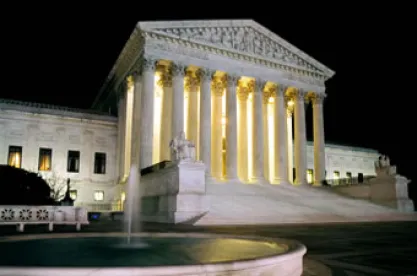In a unanimous decision, the Supreme Court of the United States reversed a decision from the U.S. Court of Appeals for the Federal Circuit, which had held that induced infringement under § 271(b) could be predicated on direct infringement, even where not all of the claim steps were performed by a single party. The Supreme Court concluded that there could be no liability for indirect infringement unless there was direct infringement, i.e., by a single party. Limelight Networks, Inc. v. Akamai Technologies, Inc., Case No. 12-786 (Supr. Ct., June 2, 2014) (Alito, Justice).
Background of the Case
Akamai is the exclusive licensee of an MIT patent that claims a method of delivering electronic data using a content delivery network (CDN). Proprietors of websites contract with Akamai to deliver the content of their websites to individual users of the internet. The patent provides that certain components of a provider’s website (e.g., large files, such as video or music files) can be designated, or tagged, to be stored on servers and accessed by internet users, which allows for increased speed of access to the content. Limelight also operates a CDN and carries out several of the claimed steps, but does not tag the components to be stored on its servers. Rather, Limelight requires its customers to perform their own tagging.
Akamai successfully sued Limelight for patent infringement and was awarded $40 million in damages. Limelight filed a judgment as a matter of law (JMOL) motion, which was denied. Thereafter, and before final judgment had entered, the Federal Circuit issued its opinion in Muniauction v. Thomson , holding that the defendant could not be held liable for direct infringement because it did not perform all of the claim steps and did not exercise control or direction over the customers that performed the remaining steps. In light of that decision, Limelight moved for reconsideration of its JMOL. The district court granted the motion, holding that Limelight could not be liable for direct infringement because it did not perform the tagging step, nor did it exercise control or direction over its customers. A three-judge panel of the Federal Circuit affirmed that decision.
Subsequently, the Federal Circuit granted en banc review and reversed the panel decision. The en banc Federal Circuit held that Limelight could have been liable for induced infringement under § 271(b) where it carried out some of the claim steps, then encouraged others to perform the remaining steps—even if there was no agency relationship involved. Ultimately, the Federal Circuit held that, while there must be direct infringement to support a claim of induced infringement, direct infringement need not be performed by a single party. Rather, the direct infringement could be divided among multiple parties, as long as each of the claim steps was ultimately performed. The Supreme Court granted certiorari to address this issue.
The Supreme Court’s Decision
Justice Alito began his analysis by repeating the uncontroversial rule that liability for induced infringement can arise only if there is some underlying direct infringement. The Supreme Court then observed that, in this case, the Federal Circuit had found a party liable for infringement under § 271(b), even though no single party had technically infringed under § 271(a) (i.e., no single party had performed all of the claimed steps). Accordingly, the Supreme Court expressed concern that a party could be held liable for induced infringement, even though the underlying conduct did not actually constitute infringement. The court then reasoned that the Federal Circuit’s opinion created a different standard for induced infringement and direct infringement, stating, “[t]he decision below would require the courts to develop two parallel bodies of infringement law: one for liability for direct infringement, and one for liability for inducement.”
The Supreme Court observed that the language of § 271 does not support a reading that induced infringement could be found without an actual finding of direct infringement under § 271(a). In support of its position, the Supreme Court noted that § 271(f)(1) permits a finding of infringement where components are combined in a manner that “would infringe the patent if such combination occurred within the United States.” In other words, § 271(f)(1) allows for infringement liability even where there is no technical finding of infringement. Thus, Justice Alito observed, when Congress intends to provide for liability for induced infringement where direct infringement has not technically occurred, “it knows precisely how to do so.” Congress did not do so, however, in § 271(b).
Assuming Muniauction was decided correctly (a proposition Justice Alito said is not decided here), the Supreme Court concluded that there could be no direct infringement unless a single actor can be held responsible for the performance of all claimed steps of the patent.
Practice Note: On June 9, 2014, the Supreme Court declined to consider Akamai’s conditional cross appeal for certiorari filed in response to a certiorari petition filed by Limelight Networks. Supr. Ct. Case No. 12-960. In the related petition, Akamai and Limelight sought to broaden the basis of Akamai’s original certiorari petition asking the Supreme Court to directly consider the issue of divided direct infringement (sometimes phrased as joint direct infringement), i.e., the Muniauction issue. Thus, the issue of whether Muniauction was correctly decided is left for another day.




 />i
/>i
